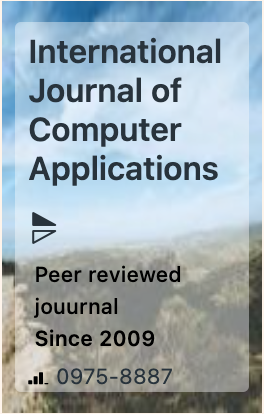The week's pick
Random Articles
Reseach Article
Hybridized Model using Clustering with Ensemble Classifier for Classification of Diseases
| International Journal of Computer Applications |
| Foundation of Computer Science (FCS), NY, USA |
| Volume 186 - Number 72 |
| Year of Publication: 2025 |
| Authors: Rashmi Gupta, Akhilesh Kumar Shrivas |
 10.5120/ijca2025924578
10.5120/ijca2025924578
|
Rashmi Gupta, Akhilesh Kumar Shrivas . Hybridized Model using Clustering with Ensemble Classifier for Classification of Diseases. International Journal of Computer Applications. 186, 72 ( Mar 2025), 42-51. DOI=10.5120/ijca2025924578
Abstract
The ensemble technology in machine learning can be used for classification purposes and it is one of the most challenging tasks for the researchers who work for improving accuracy in disease predictions. This paper propose the hybrid model that is combination of Particle Swarm Optimization (PSO), K-means clustering and ensemble classifier for classification of five different types of medical diseases. The proposed hybrid model uses PSO technique for reducing the number of features from datasets, a k-means clustering approach for reducing the instances from dataset and ensemble classifiers is used to classify the different types of diseases from five different types of datasets. The ensemble classifier uses voting scheme to ensemble the individuals base classifiers like Multilayer Perceptron (MLP), Adaboost, Bagging, Fuzzy Unordered Rule of Induction Algorithm (FURIA), and Random Forest(RF) with Naive Bayes classified where Naive Bayes is considered as a meta learner. The experiment results reveal that the combination of the ensemble classifier with PSO and k-means algorithm is an efficient novel method for disease predictions. The improved accuracy was found in between 95% to 100%. The results are evaluated and also compared with different existing models which showed better performance than others.
References
- Alaba A, Maitanmi S, Ajayi O. "An Ensemble of classification techniques for Intrusion Detection Systems", International Journal of Computer Science and Information Security, vol. 17, no. 11, pp. 24-33, 2019.
- Bauer E, Kohavi R., "Empirical comparison of voting classification algorithms: bagging, boosting, and variants", Machine Learning, vol. 36, no.1, pp. 105–139, 1999.
- Carvalho M, Ludermir TB., "Hybrid training of feed-forward neural networks with particle swarm optimization", Lecture Notes in Computer Science (Including Subseries Lecture Notes in Artificial Intelligence and Lecture Notes in Bioinformatics. 4233 LNCS, pp. 1061–1070, 2006.
- Cohagan C, Grzymala-Busse JW, Hippe ZS., "A Comparison of Three Voting Methods for Bagging with the MLEM2 Algorithm", Proceedings of the 11th international conference on Intelligent data engineering and automated learning, pp. 118-125, 2010.
- Cordón O, Kazienko P, Trawiński B., "Hybrid and ensemble methods in machine learning", New Generation Computing, vol. 29, no. 3, pp. 241–244, 2011.
- Das R, Sengur A., "Evaluation of ensemble methods for diagnosis of valvular heart disease", Expert Systems with Applications, vol. 37, no. 7, pp. 5110–5115, 2010.
- Das R, Turkoglu I, Sengur A., "Diagnosis of valvular heart disease through neural networks ensembles", Comput Methods Programs Biomed, vol. 3, pp. 185–191, 2008.
- Das R, Turkoglu I, Sengur A., Effective diagnosis of heart disease through neural networks ensembles", Expert Systems with Applications, vol. 36, no. 4, pp. 7675–7680, 2009.
- Das S, Abraham A, Konar A., "Automatic Clustering Using an Improved Differential Evolution Algorithm", IEEE Xplore, vol. 38, no. 1, pp. 218–237, 2008.
- Dietterich T G. "An Experimental Comparison of Three Methods for Constructing Ensembles of Decision Trees: Bagging, Boosting, and Randomization", Kluwer Academic Publishers, Manufactured in The Netherlands, Machine Learning, vol. 40, pp. 139–157, 2000.
- Hambali MA, Saheed YK, Oladele TO, Gbolagade M D. "Adaboost Ensemble Algorithms for Breast Cancer Classification", International Journal of Advances in Computer Research Quarterly, vol. 10 , no. 2, pp. 31-52, 2019.
- Kazemi Y, & Mirroshandel SA, "A novel method for predicting kidney stone type using ensemble learning", Artificial Intelligence in Medicine, vol. 84, pp. 117–126, 2018.
- Leon F, Floria SA, Badica C. "Evaluating the effect of voting methods on ensemble-based classification", Proceedings - 2017 IEEE International Conference on INnovations in Intelligent SysTems and Applications, pp. 1–6, 2017.
- Leung KT, Stott PD. "Empirical Comparisons of Various Voting Methods in Bagging KDD '03", Proceedings of the ninth ACM SIGKDD International conference on Knowledge discovery and data mining, pp. 595-600, 2003.
- Lin KC, Hsieh YH. "Classification of Medical Datasets Using SVMs with Hybrid Evolutionary Algorithms Based on Endocrine-Based Particle Swarm Optimization and Artificial Bee Colony Algorithms", Journal of Medical Systems, vol. 39, no. 10, pp 1-9, 2015.
- Manonmani M, Balakrishnan S. "An ensemble feature selection method for prediction of chronic diseases", International Journal of Advanced Trends in Computer Science and Engineering, vol. 9, no. 5, pp. 7405–7410, 2020.
- Mohebian MR, Marateb HR, Mansourian M, Mañanas MA, Mokarian F., "A Hybrid Computer-aided-diagnosis System for Prediction of Breast Cancer Recurrence (HPBCR) Using Optimized Ensemble Learning", Computational and Structural Biotechnology Journal, vol. 15, pp. 75–85, 2017.
- Naaz E, Sharma D, Sirisha D, Venkatesan M. , "Enhanced K-means clustering approach for health care analysis using clinical documents", International Journal of Pharmaceutical and Clinical Research, vol. 8, no. 1, pp. 60–64, 2016.
- Panthong R, Srivihok A., "Wrapper Feature Subset Selection for Dimension Reduction Based on Ensemble Learning Algorithm", Procedia Computer Science, vol. 72, pp. 162–169, 2015.
- Patil BM, Joshi RC, Toshniwal D., "Hybrid prediction model for Type-2 diabetic patients", Expert Systems with Applications, vol. 37, no. 12, pp. 8102–8108, 2010.
- Patil D, Agrawal B, Andhalkar S, Biyani R, Gund M, Wadhai DVM., "An Adaptive parameter free data mining approach for healthcare application", International Journal of Advanced Computer Science and Applications, vol. 3, no. 1, pp. 55–59, 2012.
- Purwar A, Singh SK. , "Hybrid prediction model with missing value imputation for medical data", Expert Systems with Applications, vol. 42, no. 13, pp. 5621–5631, 2015.
- Santos V, Datia N, Pato MPM., "Ensemble Feature Ranking Applied to Medical Data", Procedia Technology, vol. 17, pp.223–230, 2014.
- Sasikala S, Appavu Alias Balamurugan S, Geetha S., Multi Filtration Feature Selection (MFFS) to improve discriminatory ability in clinical data set, Applied Computing and Informatics, vol. 12, no. 2, pp. 117–127, 2016.
- Thaseen IS, Kumar CA, Ahmad A., "Integrated Intrusion Detection Model Using Chi-Square Feature Selection and Ensemble of Classifiers", Arabian Journal for Science and Engineering, vol. 44, no. 4, pp. 3357–3368, 2019.
- Van EM, Vuurpijl L, Schomaker L. "An overview and comparison of voting methods for pattern recognition", Proceedings - International Workshop on Frontiers in Handwriting Recognition, IWFHR, pp. 195–200, 2002.
- Verma L, Srivastava S, Negi PC. "A Hybrid Data Mining Model to Predict Coronary Artery Disease Cases Using Non-Invasive Clinical Data", Journal of Medical Systems, vol. 40, no. 7, pp. 1-7, 2016.
- Xue B, Zhang M, Member S, Browne WN, "Particle Swarm Optimization for Feature Selection in Classification : A Multi-Objective Approach", IEEE Transactions on Cybernetics,1–16, 2012.
- Zhang Y, Zhang H, Cai J, Yang B. , “A weighted voting classifier based on differential evolution”, Abstract and Applied Analysis, 1-6, 2014.
- Tigga NP, Garg S. “Prediction of Type 2 Diabetes using Machine Learning Classification Methods”, Procedia Computer Science, vol. 167, pp. 706–716, 2020.
- Ahmed N, Ahammed R, Islam MM, Uddin MA Akhter A, Talukder MA , Paul BK., “ Machine learning based diabetes prediction and development of smart web application”, International Journal of Cognitive Computing in Engineering, vol. 2, pp. 229–241, 2021.
- Massari HE, Sabouri Z, Mhammedi S ,Gherabi N., “Diabetes Prediction Using Machine Learning Algorithms and Ontology”, Journal of ICT Standardization, vol. 10, no. 2, pp. 319–338, 2022.
- Phongying M, Hiriote S., “Diabetes Classification Using Machine Learning Techniques”, Computation, vol. 11, pp. 1-17, 2023.
- Karthick K, Aruna SK, Samikannu, Kuppusamy R, Teekaraman Y, Thelkar AR., “Implementation of a Heart Disease Risk Prediction Model Using Machine Learning”, Computational and Mathematical Methods in Medicine, pp. 1-14, 2023.
- Debal, DA, Sitote, TM., “Chronic kidney disease prediction using machine learning techniques”, J Big Data, vol. 9, no. 109, pp. 1-19, 2022.
- Alyas T, Hamid M, Alissa K, Faiz T, Tabassum N, Ahmad A., “Empirical Method for Thyroid Disease Classification Using a Machine Learning Approach”, BioMed Research International, pp. 1-10, 2022.
- Sun J, Yao K, Huang G, Zhang C, Leach M, Huang K, Yang X., “Machine Learning Methods in Skin Disease Recognition: A Systematic Review”, Processes.2023, vol.11, no. 4, pp. 1-16, 2023.
- Open UCI repository: https://archive.ics.uci.edu/datasets (Accessing date: 25-10-2022).
Index Terms
Keywords

